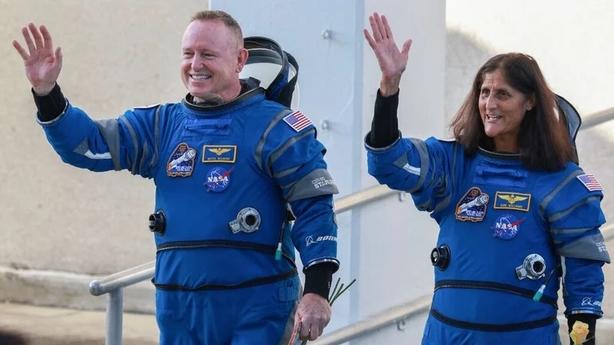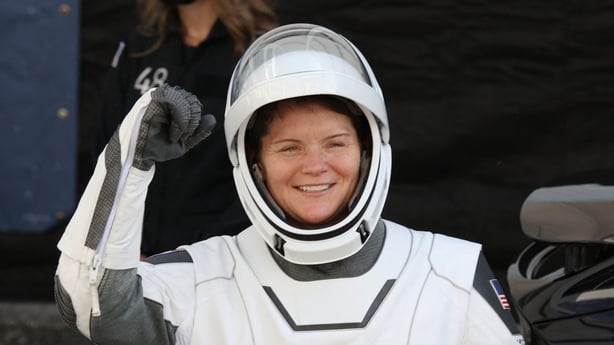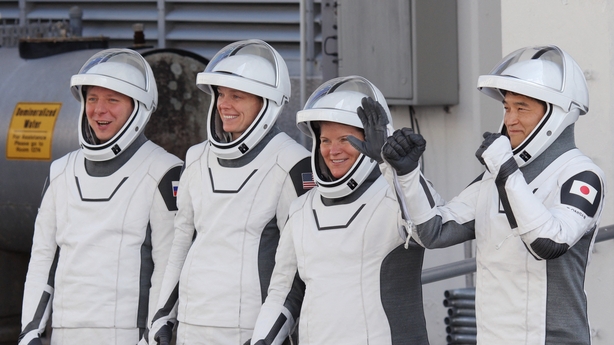NASA and SpaceX have launched a long-awaited crew to the International Space Station that opens the door to bringing home US astronauts Butch Wilmore and Suni Williams, who have been stuck on the orbital lab for nine months.
SpaceX's Falcon 9 rocket lifted off at 7.03pm local time (11.03pm Irish time) from NASA's Kennedy Space Center in Florida carrying four astronauts who will replace Mr Wilmore and Ms Williams, both of whom are veteran NASA astronauts and retired US Navy test pilots and were the first to fly Boeing's faulty Starliner capsule to the ISS in June.
Otherwise a routine crew rotation flight, yesterday's Crew-10 mission is a long-awaited first step to bring the astronaut duo back to Earth - part of a plan set by NASA last year that more recently has been given greater urgency by President Donald Trump.
The Crew-10 launch occurred as Mr Wilmore and Ms Williams were asleep in their daily schedule on the station, Dina Contellam, deputy manager of NASA's ISS programme, told reporters after the launch.

After the Crew-10 astronauts' ISS arrival at 11.30pm local time, Mr Wilmore and Ms Williams are scheduled to depart on Wednesday as early as 4am local time tomorrow, along with NASA astronaut Nick Hague and Russian cosmonaut Aleksandr Gorbunov.
Mr Hague and Mr Gorbunov flew to the ISS in September on a Crew Dragon craft with two empty seats for Mr Wilmore and Ms Williams.
The Crew-10 crew, which will stay on the station for roughly six months, includes NASA astronauts Anne McClain and Nichole Ayers, Japanese astronaut Takuya Onishi and Russian cosmonaut Kirill Peskov.
Planning for the unexpected
Minutes after reaching orbit, Ms McClain, part of NASA's astronaut corps since 2013, introduced the mission's microgravity indicator - per tradition in American spaceflight to signal the crew safely reached space - as a plush origami crane, "the international symbol for peace, hope and healing".
"It is far easier to be enemies than it is to be friends, it's easier to break partnerships and relationships than it is to build them," Ms McClain, the Crew-10 mission commander, said from the Crew Dragon capsule, her communications live-streamed by NASA.
"Spaceflight is hard, and success depends on leaders of character who choose a harder right over the easier wrong, and who build programmes, partnerships and relationships. We explore for the benefit of all," she said.

The mission became entangled in politics as Mr Trump and his adviser Elon Musk, who is also SpaceX's CEO, urged a quicker Crew-10 launch and claimed, without evidence, that former president Joe Biden had abandoned Mr Wilmore and Ms Williams on the station for political reasons.
"We came prepared to stay long, even though we planned to stay short," Mr Wilmore told reporters from space earlier this month, adding that he did not believe NASA's decision to keep them on the ISS until Crew-10's arrival had been affected by politics.
"That's what your nation's human spaceflight programme is all about," he said, "planning for unknown, unexpected contingencies. And we did that."
The Crew-10 mission is part of a normal crew rotation happening at an unusual time for NASA's ISS operations - rather than a dedicated mission to retrieve Mr Wilmore and Ms Williams, who will return to Earth as late additions to NASA's Crew-9 crew.
Mr Musk says SpaceX had offered a dedicated Dragon mission for the pair last year as NASA mulled ways to bring the two back to Earth.
But NASA officials have said the two astronauts have had to remain on the ISS to maintain adequate staffing levels, and that it did not have the budget or the operational need to send a dedicated rescue spacecraft.
Having seen their mission turn into a normal NASA rotation to the ISS, Mr Wilmore and Ms Williams have been doing scientific research and conducting routine maintenance with the other five astronauts.

Ms Williams told reporters earlier this month that she was looking forward to returning home to see her two dogs and family. "It's been a roller coaster for them, probably a little bit more so than for us," she said.
'Unusual' mission preparations
Mr Trump and Mr Musk's demand for an earlier return for Mr Wilmore and Ms Williams was an unusual intervention into NASA operations.
The agency later brought forward the Crew-10 mission from 26 March, swapping a delayed SpaceX capsule for one that would be ready sooner.
The pressure from Mr Musk and Mr Trump has hung over a NASA preparation and safety process that normally follows a well-defined course.
NASA's Commercial Crew Programme manager, Steve Stich, said preparing for the mission had been an "unusual flow in many respects."
The agency had to address some "late-breaking" issues, NASA space operations chief Ken Bowersox told reporters, including investigating a fuel leak on a recent SpaceX Falcon 9 launch and deterioration of a coating on some of the Dragon crew capsule thrusters.
Mr Bowersox said it was hard for NASA to keep up with SpaceX: "We're not quite as agile as they are, but we're working well together."

